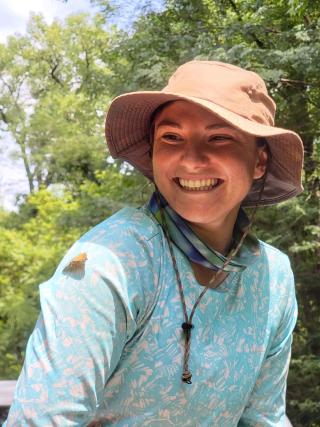Chelsea Winter is an alum of the CHRM program, having received her master's degree in 2024. Her thesis is titled Serving Up History Through Protein Analysis: An Investigation of the Shell (LA 20241) and Pecan (LA 38597) Sites, New Mexico. Abstract: Poor faunal preservation in Southeast New Mexico (SENM) has left a gap in the archaeological record for this region. What plant and animal food resources were collected, processed, and/or consumed by the site’s indigenous inhabitants in this area during the Archaic and Early Formative Periods? A way to fill that informational gap is with multidisciplinary analyses such as pollen, phytoliths, starch grains, and residues through the Fourier-transform infrared spectroscopy (FTIR) method. These analyses have been applied successfully in excavation projects in the Southeast New Mexico SENM region.This study aims to investigate what plants and animals were processed at Archaic period to the Early Formative sites LA 20241 and LA 38597 through protein residue analysis. This region is quickly being consumed by the oil field industry and it is imperative that as much information about the area and its past peoples be gathered, before the history is erased forever. This thesis presents the methods, results, and findings from a protein residue analysis study using tools from these sites and demonstrates the use of protein residue analysis within this region. Despite this being a rather costly process, a programmatic agreement established between agencies operating in the area can allow for higher budgets for cultural resource management work. Protein residue analysis is at least a three-day process that included extracting the proteins from the tools, creating the gels to run through the cross electrophoresis, pressing and drying, and lastly staining and drying the gels for reading the results. Thirty tools were tested using Cross-electrophoresis (CIEP) to find what tools reacted with which antisera (proteins) to the family level. The results present the range of reactions with the strongest positives being, chicken, mouse, yucca, and agave. The analysis presents the use and importance of all the resources identified in this study. This data allows us to know what plants and animals were processed at the shell (LA 20241) and the pecan (LA 38597) sites providing a broader glimpse into the lives of the people who thrived in this region. It also stands to be a useful technique to be applied in SENM answering broader research questions.
Following below is an archived profile.
Chelsea Winter, B.A, Anthropology joined SEARCH in July 2022 as a Lead Archaeologist with five years of experience in archaeology, artifact analysis, and report production. Her fieldwork experience has been focused around the Permian Basin, but has worked in parts of Arizona, Texas, northern New Mexico, and most recently branching out Illinois. Ms. Winter earned her bachelor’s degree in Anthropology from University of Alaska Fairbanks and has not yet obtained a master’s degree but is currently looking at grad schools. She completed field school with the University of Alaska Fairbanks at the Mead site in 2012 where she was involved in a project to further understand how the people of interior Alaska utilized their settlement throughout time and space. This site is documented as one of the oldest sites in North America. Ms. Winter holds Bureau of land management and State permits in New Mexico, and her research interests include Southwest lithic technologies.
And: She was born and raised in Alaska and enjoys DIY home projects while listening to scary story podcasts.



